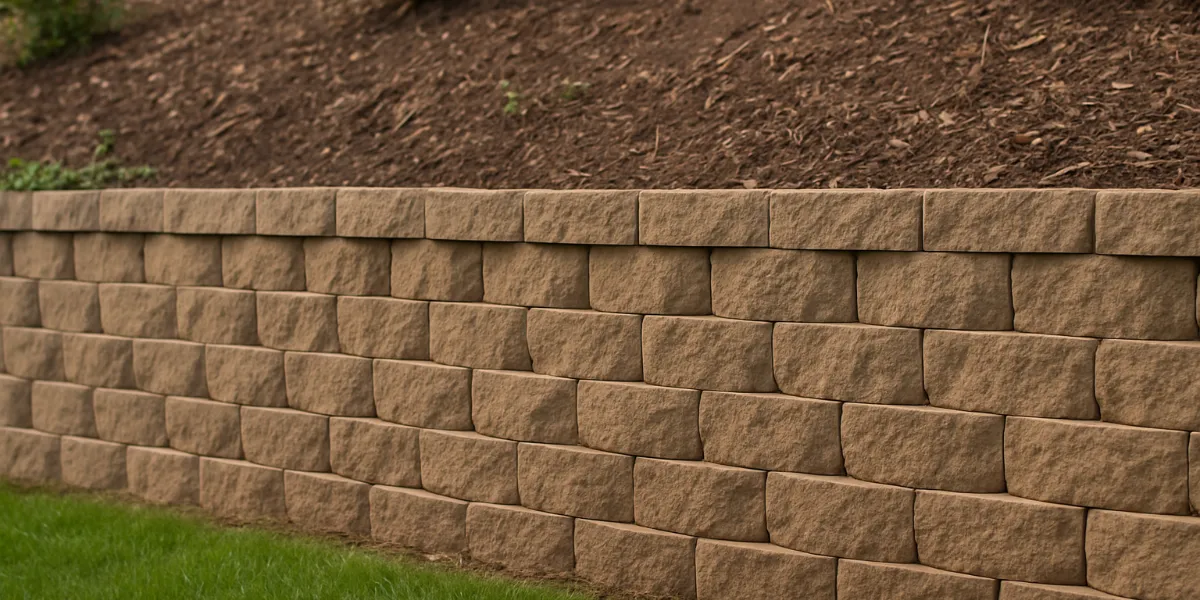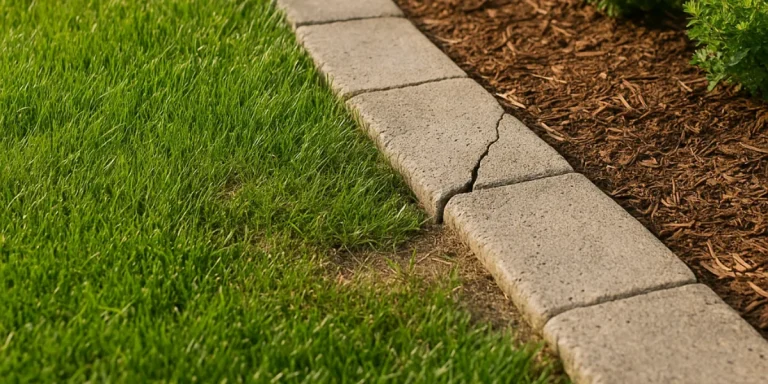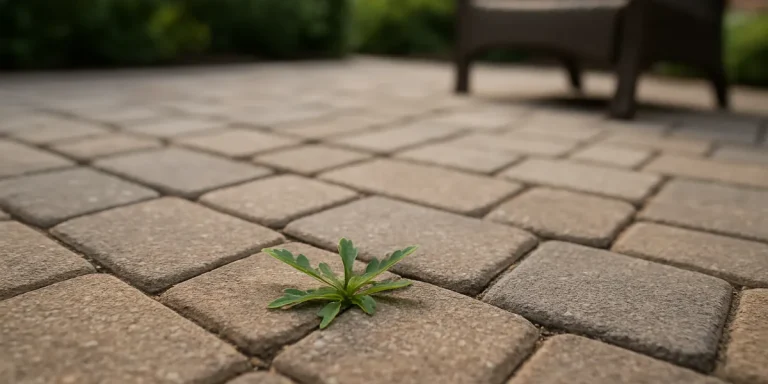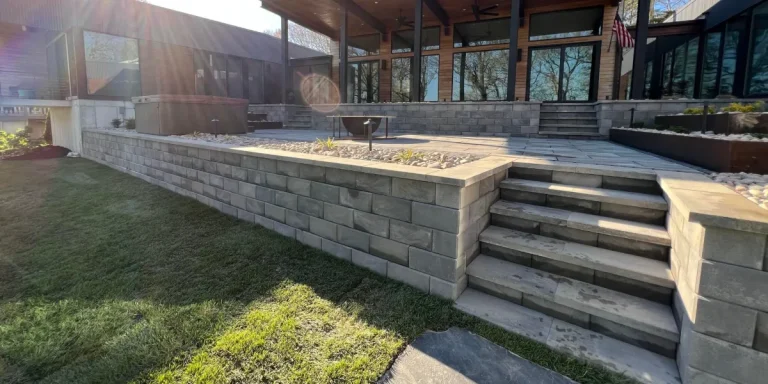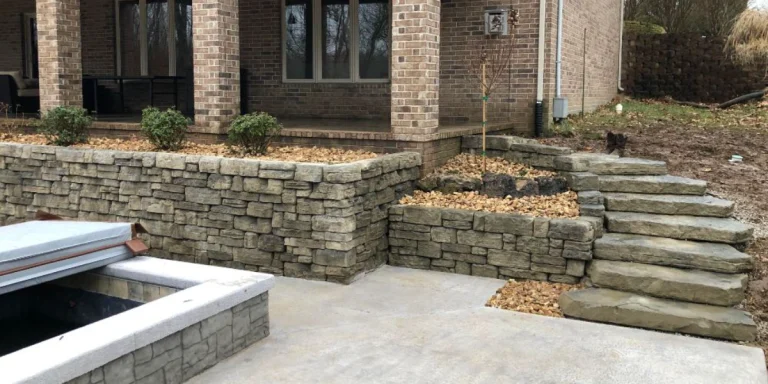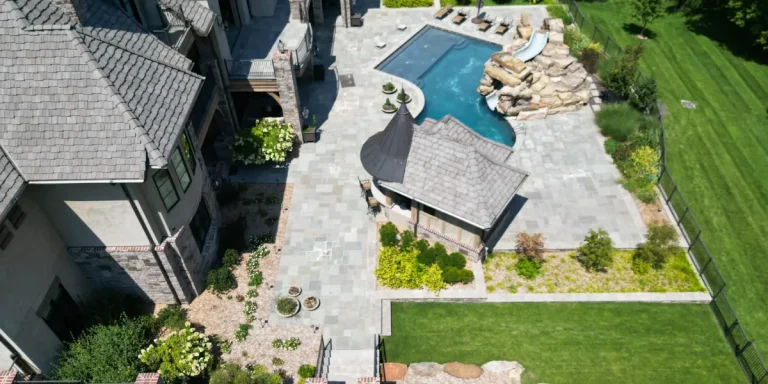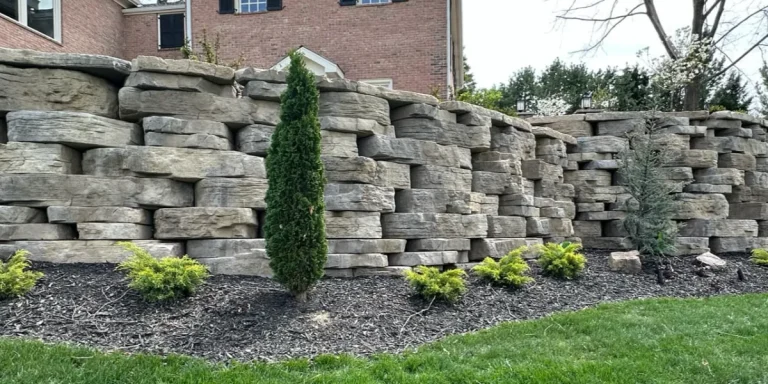How to Fix Soil Washout Behind a Retaining Wall
Erosion and soil washout behind retaining walls are common issues—especially in Ozark’s steep or heavily landscaped yards. If you’ve noticed gaps, settling soil, or water pooling near the wall’s base, it’s essential to address the problem quickly. Hunter Hardscapes & Outdoor is a trusted, experienced landscaping and hardscaping company serving Ozark and surrounding areas. In this guide, we’ll help you identify, repair, and prevent soil washout behind your retaining wall.
Why soil washout happens
Soil washout behind a retaining wall is usually the result of water not being properly managed. Over time, this water displaces soil, undermines structural integrity, and causes erosion-related damage.
Common causes include:
-
- Insufficient drainage systems: If water can’t escape from behind the wall, it builds up pressure and begins to saturate and displace the soil. Without proper drain pipes, gravel backfill, or weep holes, the wall essentially becomes a dam—and eventually, the water finds a way through.
- Heavy rain and surface runoff: In Ozark and surrounding areas, intense storms and poor yard grading can send large volumes of water down slopes. This accelerates erosion, especially on hillsides or improperly sloped lots.
- Improper backfill selection: Using loose soil, clay, or other fine materials behind the wall can lead to quick saturation and movement. These materials retain moisture and lack the structural resistance needed to stay in place under pressure.
- Structural flaws or age-related deterioration: Gaps between wall blocks, shifting foundations, or failing mortar joints allow water and soil to escape. Over time, even well-built walls can degrade if not properly maintained.
- Lack of vegetation or surface protection: Bare soil above or behind the wall can erode more easily without plants, mulch, or stone to slow water movement and hold soil in place.
Unchecked, these issues can cause walls to bulge, lean, or collapse. Washout also contributes to sinkholes, kills plantings, and allows water to reach foundations or basements. That's why timely inspection and correction are essential to prevent more costly repairs later.
Signs you need to repair your wall
Watch for these red flags:
-
- Bulging, tilting, or cracking in wall segments
- Gaps visible behind the wall when soil shifts
- Soil or mulch being displaced downslope
- Standing water at the base or behind the structure
- Exposed footing or gravel that was behind the wall
If you've spotted any warning signs—or just want to prevent them—addressing drainage and backfill issues quickly is critical.
Step-by-step solutions for soil washout
Solving soil erosion behind a retaining wall requires a combination of proper drainage, structural repairs, and preventative surface treatments. Here’s how Hunter Hardscapes & Outdoor approaches the problem:
1. Improve drainage
The root cause of most washout issues is poor water management. By addressing how water flows and drains around your wall, we can reduce pressure buildup and keep soil in place.
Common drainage solutions we install include:
-
-
- Perforated drain pipes (drain tile) at the base of the wall to collect and divert water safely
- Gravel backfill (3/4" clean stone) to promote fast drainage behind the wall structure
- Weep holes in natural stone or masonry walls to relieve hydrostatic pressure
- French drains or gravel swales to redirect surface runoff away from the wall area
- Downspout extensions to prevent roof water from pooling near retaining walls
-
Improper drainage is the #1 reason retaining walls fail over time—so we make it a priority on every project.
2. Use proper backfill materials
Backfill—the material placed behind the wall—matters more than most homeowners realize. Using the wrong fill can create a sponge that holds water and destabilizes the wall.
We recommend:
-
-
- Crushed stone or angular gravel for the first 12–24 inches directly behind the wall
- Compacted soil with moderate drainage characteristics for upper fill layers, if applicable
- Avoiding clay or topsoil, which retain water and break down under pressure
- Geotextile fabric to separate soil from gravel and prevent clogging of drainage pathways
-
A well-constructed backfill system protects both the wall’s structure and your surrounding landscape.
3. Re-compact and rebuild where needed
If erosion has already occurred, we may need to excavate and rebuild part of the wall. Here's how we do it:
-
-
- Remove all loose, wet, or slumped soil from behind the wall
- Install a new base layer of gravel and ensure it's properly compacted
- Rebuild or reset the wall blocks, making sure alignment and height are restored
- Add backfill in compacted layers (6–12 inches at a time) to prevent future settling
- Install a drainage fabric or mat behind the wall for added protection
-
This process restores stability and gives the wall a fresh start with proper materials and support.
4. Add surface protection to stop future erosion
Once the wall and drainage systems are corrected, surface erosion must also be addressed—especially on the slope above the wall.
Protective options include:
-
-
- Landscape edging to contain mulch and topsoil
- Groundcover plantings like creeping juniper, sedum, or liriope to hold soil in place
- Erosion control blankets for newly planted slopes or disturbed soils
- Boulder edging or retaining caps to help redirect runoff and soften the transition
-
Preventing water from washing over the top of your retaining wall is just as important as managing it behind the wall.
With every erosion repair, Hunter Hardscapes & Outdoor prioritizes long-term stability, aesthetic improvements, and proper drainage. If your wall is showing signs of soil loss or water damage, we’ll walk you through the options and recommend a solution that fits your property and budget.
Why professional repair matters
Correcting soil washout is more than just digging out the problem area and refilling it. It requires a deeper understanding of drainage engineering, soil behavior, and retaining wall construction standards. A poorly executed repair can lead to recurring erosion, structural failure, or damage to nearby landscaping—and often ends up costing more in the long run.
At Hunter Hardscapes & Outdoor, we specialize in retaining wall repair, drainage installation, and hardscaping solutions designed to solve root causes—not just symptoms. Every project is approached with a long-term mindset, using proper materials, proven techniques, and tailored designs for Southwest Missouri’s challenging weather and soil conditions.
We’re often called in to fix DIY or contractor-installed walls that weren’t built with proper drainage or backfill. Our team brings experience, accountability, and the right tools to get the job done right the first time.
Case study: Fixing washout in Ozark
A homeowner in Ozark, Missouri contacted us after noticing increasing gaps and slumping behind their tiered concrete block retaining wall. Rainwater was pooling above the wall, and over time, the soil had begun to erode, exposing roots and leaving the area unstable.
Here’s how we solved it:
-
- Excavated behind the wall and removed loose soil and debris
- Installed a perforated collector pipe to capture subsurface water
- Backfilled the space with clean gravel, compacted in layers
- Added a drainage mat to reduce hydrostatic pressure
- Installed low-maintenance groundcover to protect exposed areas and slow surface runoff
The result? The wall was fully stabilized, no more gaps or shifting, and the entire slope has held up through several Ozark rainstorms since. The homeowner not only regained peace of mind but also boosted the curb appeal and value of their outdoor space.
If you’re dealing with erosion behind a retaining wall, let Hunter Hardscapes & Outdoor help you fix it right—with lasting materials, expert design, and a commitment to quality.
Preventative maintenance tips
-
- Inspect drainage annually, especially after storms
- Keep topsoil, mulch, and plants away from wall edges
- Ensure gutters and downspouts direct water away from retaining structures
- Schedule seasonal inspections with Hunter Hardscapes & Outdoor to catch early issues
Proudly serving our southwest Missouri communities
We offer retaining wall services, drainage solutions, landscape design, and hardscape installation in:
-
- Ozark
- Springfield
- Nixa
- Rogersville
- Republic
- Clever
- Highlandville
- Sparta
- And other nearby areas
Secure your wall before it's too late
Protect your investment—schedule a retaining wall inspection today
Don’t let erosion compromise your retaining wall or yard safety. Hunter Hardscapes & Outdoor provides comprehensive solutions—from drainage fixes to backfill replacement—to restore and protect your structure. Call us or request a free estimate online. We proudly serve Ozark and surrounding Missouri towns with expert landscaping, hardscaping, drainage, and retaining wall repair services you can trust.

